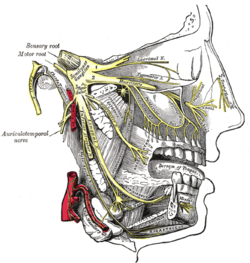Auriculotemporal branch
| Auriculotemporal nerve | |
|---|---|

Sympathetic connections of the otic and superior cervical ganglia. (Auriculotemporal labeled at top right.)
|
|

|
|
| Details | |
| From | mandibular nerve |
| Innervates | temple |
| Identifiers | |
| Latin | Nervus auriculotemporalis |
| TA | A14.2.01.074 |
| FMA | 53000 |
|
Anatomical terms of neuroanatomy
[]
|
|
The auriculotemporal nerve is a branch of the mandibular nerve (V3) that runs with the superficial temporal artery and vein, and provides sensory innervation to various regions on the side of the head.
The auriculotemporal nerve arises as two roots from the posterior division of the mandibular nerve. The mandibular nerve is a branch of the trigeminal nerve, and the mandibular nerve exits the skull through the foramen ovale. These roots encircle the middle meningeal artery (a branch of the mandibular part of the maxillary artery, which is in turn a terminal branch of the external carotid artery). The roots encompass the middle meningeal artery then converge to form a single nerve.
The auriculotemporal nerve passes between the neck of the mandible and the sphenomandibular ligament, gives off parotid branches and then turns superiorly, posterior to its head and moving anteriorly, gives off anterior branches to the auricle. It then crosses over the root of the zygomatic process of the temporal bone, deep to the superficial temporal artery.
The somatosensory root (superior) originates from branches of the mandibular nerve (cranial nerve V), which pass through the otic ganglion without synapsing. Then they form the somatosensory (superior) root of the auriculotemporal nerve. The two roots re-unite, and shortly after the branching of secretomotor fibers to the parotid gland (parotid branches), the auriculotemporal nerve comprises exclusively somatosensory fibers, which ascend to the superficial temporal region. There, it supplies the auricle, external acoustic meatus, outer side of the tympanic membrane and the skin in the temporal region (superficial temporal branches). It also carries a few articular branches that go on to supply the temporomandibular joint.
...
Wikipedia
